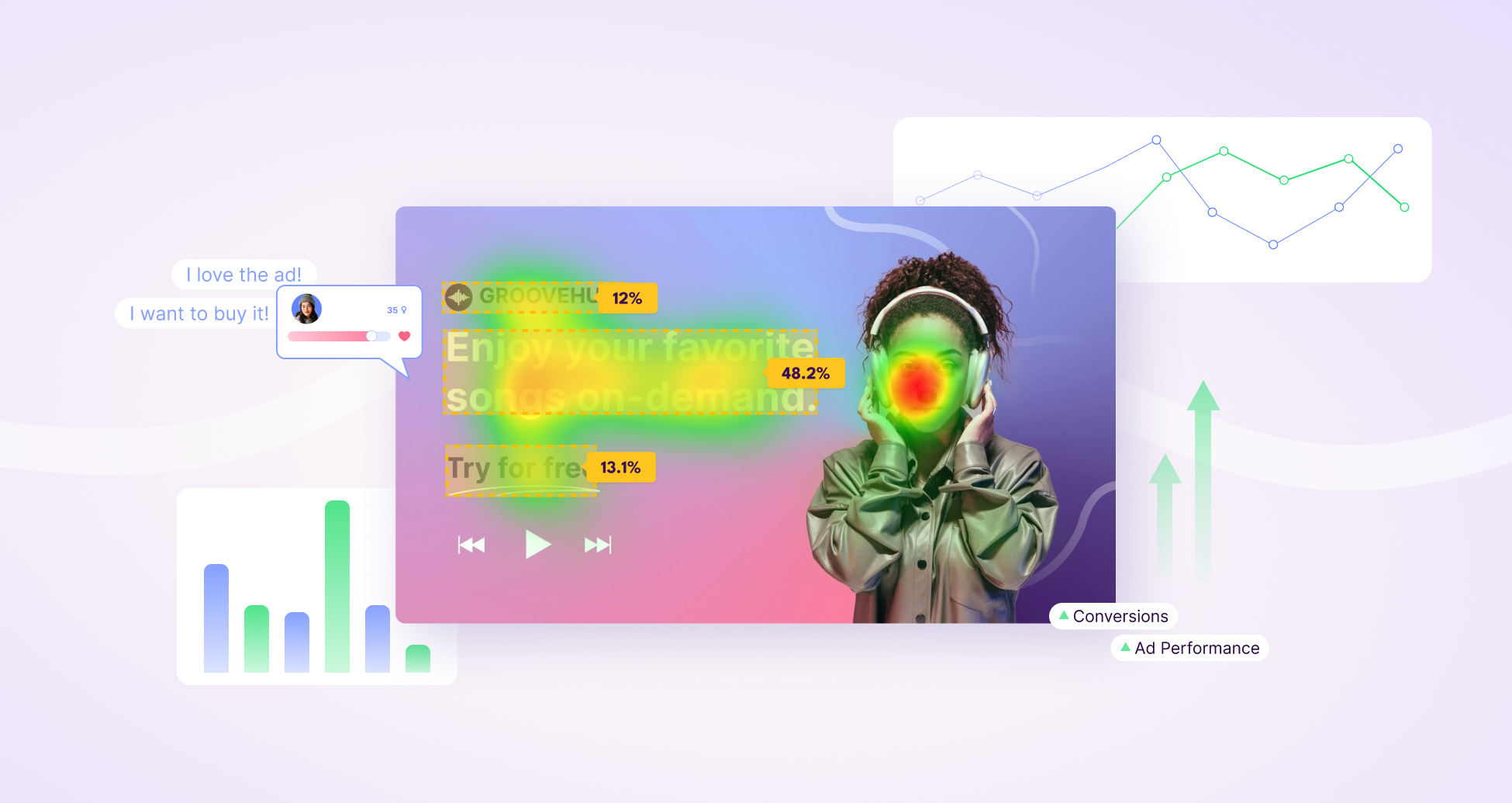
Ad testing enables marketing teams to evaluate how advertisements perform before and during a campaign. Ad testing improves message clarity, increases campaign performance, and reduces media waste. This guide explains how ad testing works, which methods and metrics to use, which tools provide reliable insights, and how platforms like Meta and TikTok shape the testing process. Artificial intelligence (AI) in ad testing is also covered. For detailed explanations of tools, methods, metrics, platforms, and AI use cases, this guide includes links to individual deep-dive articles.
Ad testing is the process of evaluating an advertisement’s performance based on real audience responses. These evaluations are used to measure attention, recall, emotional reaction, and purchase intent before or during a campaign.
Advertisement testing helps marketers refine creatives across formats like video ads, banners, and social media content. Testing is usually done either before launch (pre-testing) or during a live campaign (in-market testing).
The purpose of ad testing is to improve ad performance and avoid wasted media spend. Campaigns that include testing consistently show better engagement, higher ROAS, and fewer creative missteps.
Ad testing can focus on many different elements—your audience, platform, timing, or message. But one of the most impactful areas to test is often the creative itself. Swapping out visuals, headlines, or even tone can lead to major shifts in attention and performance. This is known as creative testing, and it’s a fast, focused way to see what resonates before you launch.
Read the full guide to creative testing.
Ad testing improves ad performance by replacing guesswork with real audience data. When marketers test creatives before scaling, they can avoid underperforming ads and make better use of their budget.
Testing reveals which visuals, messages, and formats resonate most with the target audience. These insights help teams make confident creative decisions and reduce the risk of campaign failure.
Brands that test ads consistently gain a competitive edge. With every test, they learn what drives attention and action—building stronger campaigns over time.
Ad testing works by exposing an advertisement to a sample audience and measuring their responses. These responses are collected through surveys, biometric tools, attention tracking, or behavioral data.
The process can take place before a campaign (pre-testing) or during it (in-market testing). Pre-testing helps optimize the creative before launch, while in-market testing tracks live performance.
Metrics gathered during ad testing include attention, engagement, brand recall, and purchase intent. These data points reveal whether the ad meets its goals and how it can be improved.
Ads should be tested both before launch and during live campaigns to ensure effectiveness at every stage. Pre-testing helps refine creative elements, while in-market testing tracks performance in real-world conditions.
Early testing is ideal during the concept or storyboard phase. This allows teams to adjust messages, visuals, or formats before investing in full production.
Ongoing testing during a campaign helps identify underperforming assets quickly. These insights support real-time optimization and better media allocation.
Ad testing methods are structured approaches used to measure how well different ad variations perform in relation to audience engagement, brand perception, and business outcomes. These methods allow marketers to validate and optimize creatives by testing messaging, visuals, and formats across different stages of a campaign. Each method is designed to uncover specific insights—ranging from attention prediction to real-time behavior tracking—so teams can make informed decisions before scaling an ad.
There are 7 widely used ad testing methods that support campaign development and performance measurement across channels and formats.
The 7 most common ad testing methods are listed below.
Read our full guide to ad testing methods and techniques here.
Choosing the right ad testing method depends on campaign goals, available resources, and the stage of the creative. Different methods serve different purposes—some focus on optimization, others on validation.
To select the best approach, marketers should consider factors like budget, timeline, testable variables, and data needs. For example, pre-testing works well for fast iteration, while brand lift studies are better suited for long-term impact measurement.
Using a combination of methods often yields the most reliable results. Layering qualitative insights with quantitative data ensures both creative quality and measurable performance.
Ad testing tools are technologies and research methods used to measure ad performance before and during a campaign. These tools analyze creative effectiveness by collecting predictive data, real user feedback, biometric responses, and platform-specific performance metrics. There are four main categories of ad testing tools, each offering distinct approaches depending on campaign goals, audience insights, and creative testing formats.
The 4 most common types of ad testing tools are listed below.
Explore the full list of ad testing tools here.
When testing ads, it’s important to understand the difference between creative and contextual elements. Creative elements are the parts of the ad itself—like visuals, messaging, and layout—that directly influence how the audience perceives and interacts with the content. Contextual elements, on the other hand, relate to where, when, and to whom the ad is shown, including factors like audience segments and placement.
Both creative and contextual elements play critical roles in ad testing, and exploring examples under each category helps marketers optimize their campaigns effectively.

Creative elements are the core components of an advertisement that directly impact how the audience experiences the message. Testing these elements helps marketers understand which visuals, copy, and design choices resonate best with viewers.
This category includes various sub-elements that influence ad performance, such as:
Each plays a unique role in shaping engagement and effectiveness.
Visuals encompass all images, graphics, videos, and animations used in an ad. They play a crucial role in capturing attention, conveying messages quickly, and evoking emotional responses.
Testing visuals helps determine which styles, colors, and compositions drive higher engagement and recall. For example, bright colors or human faces might boost attention, while cluttered images could reduce clarity.
Marketers often test different visual treatments to find the most impactful approach for their audience.
Copy or messaging refers to the words used in an ad, including headlines, body text, and taglines. It shapes how the brand communicates value, tone, and call-to-action to the audience.
Testing copy helps identify the language, style, and message that resonate most effectively, influencing both attention and conversion. For instance, emotional versus rational appeals might perform differently depending on the target segment.
Marketers often experiment with various copy versions to optimize clarity, persuasion, and alignment with brand voice.
The call-to-action (CTA) is the part of the ad that prompts the audience to take a specific action, like “Buy Now,” “Sign Up,” or “Learn More.” It drives the conversion process by guiding viewers toward the desired response.
Testing different CTAs helps marketers find the wording, design, and placement that most effectively motivate action. For example, using action-oriented verbs or urgency cues can impact click rates.
Optimizing CTAs ensures the ad not only grabs attention but also drives measurable results.
Colors and branding elements include the palette, logos, and brand identity cues used in an ad. These components help build brand recognition and convey the brand’s personality.
Testing colors and branding evaluates which combinations enhance recall and emotional connection without overwhelming the message. For example, bold brand colors may strengthen identity but need to be balanced with readability.
Marketers use these insights to maintain consistent brand presence while optimizing creative appeal.
Format and layout refer to the overall structure and arrangement of elements within an ad. This includes things like the positioning of visuals, text hierarchy, and whitespace usage.
Testing different formats and layouts helps determine which configurations improve clarity, flow, and engagement. For example, placing the key message above the fold or using clean, uncluttered designs can boost effectiveness.
Marketers refine format and layout to make ads easier to digest and more visually appealing.
Sound and voiceover include all audio elements in an ad, such as music, narration, and sound effects. They contribute to the mood, reinforce messaging, and can significantly impact viewer engagement.
Testing sound and voiceover helps identify which audio styles and tones resonate best with the audience and complement the visual content. For example, upbeat music might increase energy, while a calm voiceover could build trust.
Optimizing these elements ensures the ad connects emotionally and holds attention across different listening contexts.
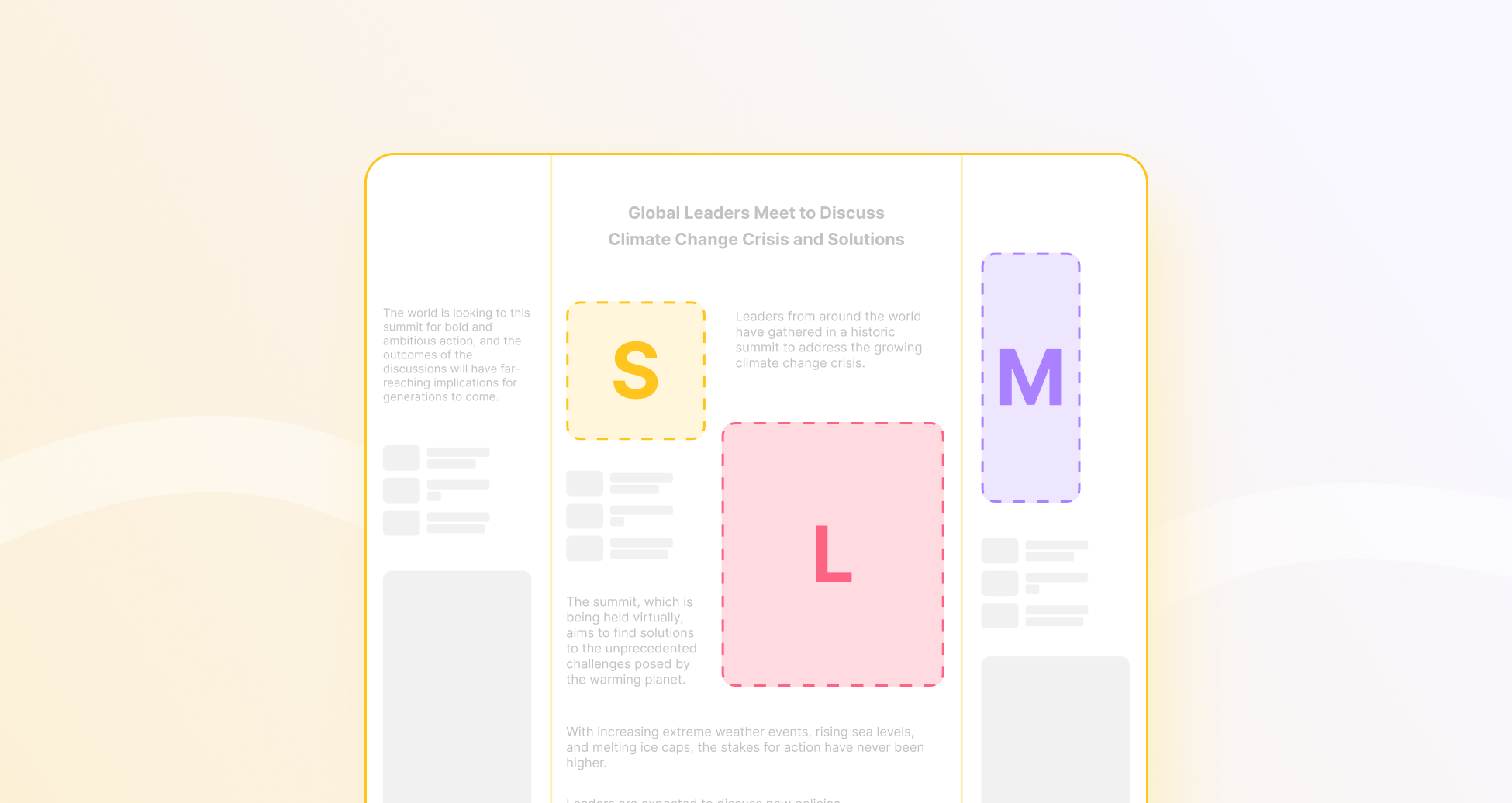
Contextual elements relate to the environment in which an ad is served rather than the ad’s creative itself. These factors influence how, when, and to whom an ad is delivered, affecting its overall effectiveness.
Understanding and testing these elements help marketers optimize ad placement, timing, and targeting to ensure the message reaches the right audience at the right moment.
This category includes important factors such as:
Each element shapes the context that frames audience perception and response.
Audience segments define specific groups of people targeted by an ad based on demographics, interests, behaviors, or other criteria. Proper segmentation ensures the message reaches the most relevant viewers.
Testing different audience segments helps marketers identify which groups respond best to certain creatives or offers. For example, younger demographics might prefer different messaging styles compared to older audiences.
Optimizing audience targeting increases ad relevance, engagement, and conversion rates.
Placement and platform refer to where an ad appears, such as social media feeds, websites, or streaming services. Each platform has unique user behaviors and technical formats that influence ad effectiveness.
Testing placements and platforms helps marketers understand which environments best support their campaign goals. For example, video ads may perform differently on mobile apps versus desktop websites.
Optimizing placement ensures ads are shown where they will have the greatest impact.
Timing or time of day relates to when an ad is served to the audience. Viewer behavior and receptiveness can vary throughout the day and week.
Testing different time slots helps marketers identify peak engagement periods for their target audience. For instance, evenings might be better for entertainment ads, while business hours could suit B2B messaging.
Optimizing ad timing maximizes reach and effectiveness by aligning with audience availability.
Ad length refers to the duration of video or audio ads or the amount of content in static formats. The optimal length depends on platform norms and audience attention spans.
Testing different ad lengths helps marketers balance message completeness with viewer engagement. For example, shorter ads may perform better on fast-scrolling social platforms, while longer formats might suit storytelling on video platforms.
Optimizing ad length ensures the creative fits the context and holds attention effectively.
The table below summarizes the ad elements that advertisers and marketers test during ad testing.
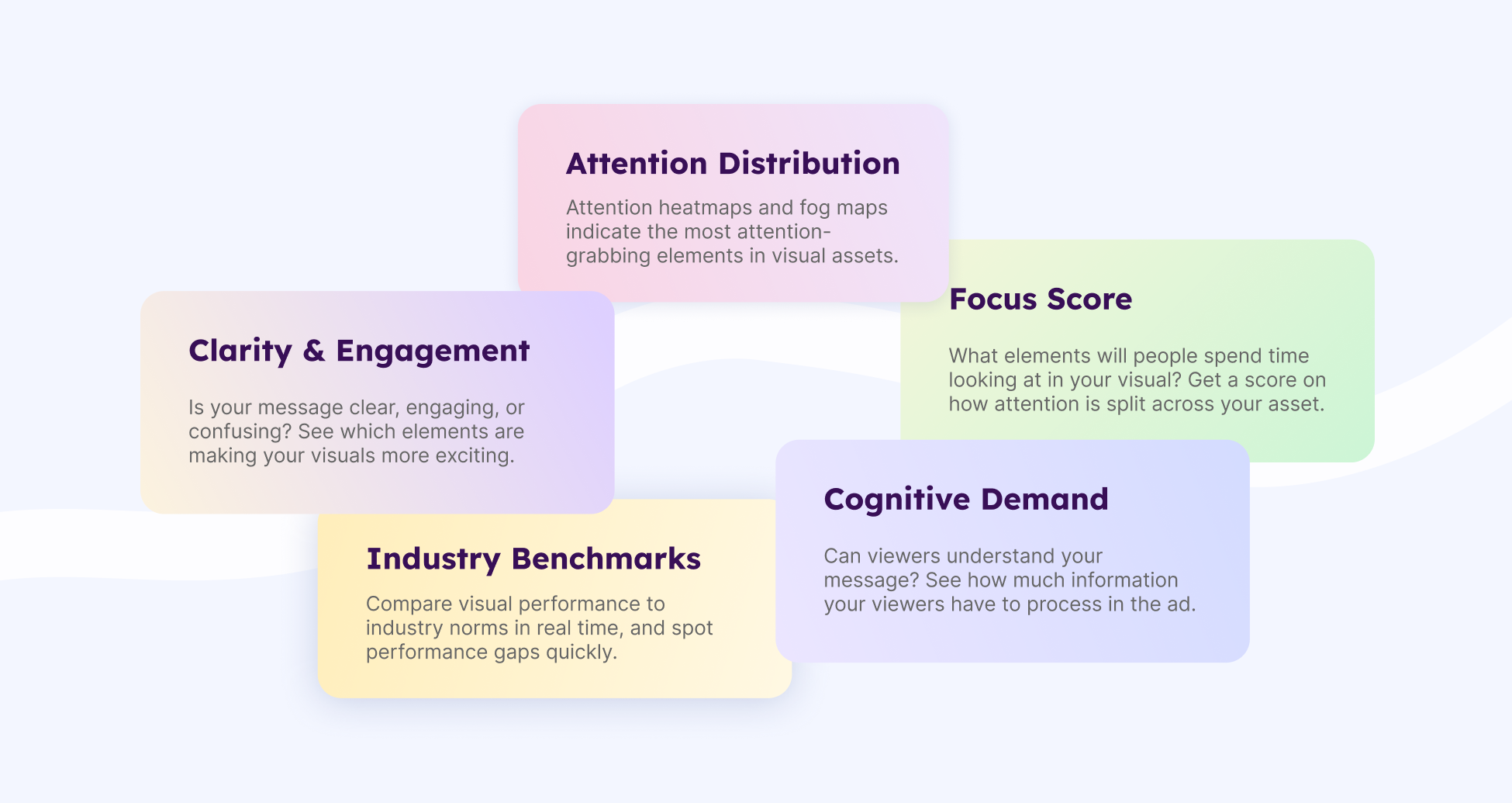
Ad testing metrics are quantitative indicators used to evaluate how advertisements perform across key dimensions such as user behavior, brand perception, emotional impact, and media efficiency. These metrics provide marketers with measurable insights into both short-term campaign outcomes and long-term brand effects. Accurate measurement helps teams optimize creatives, allocate media budgets, and validate performance across platforms.
There are 4 main types of ad testing metrics that capture the full scope of an ad’s effectiveness.
The 4 most commonly used metric types are listed below.
Learn how to measure ad effectiveness using these key metrics here.
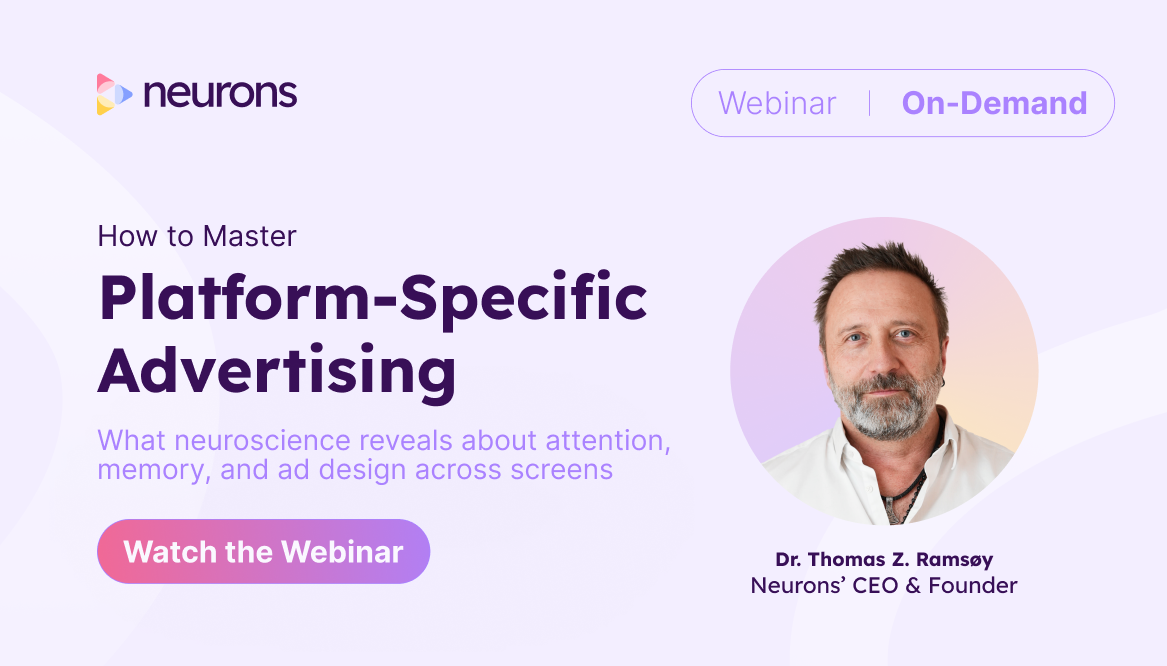
Ad testing on major platforms involves tailoring creative evaluation to each channel’s unique formats, audience expectations, and technical constraints. Each platform demands different creative styles, lengths, and visual compositions—from Facebook’s mix of video and images to TikTok’s fast-paced vertical clips and YouTube’s longer storytelling formats.
Marketers must optimize ads specifically for each environment to maximize impact and efficiency. Tools like Neurons AI support this by allowing users to set campaign objectives aligned with the platform’s nuances and receive immediate feedback on how to improve ads accordingly.
Key platform testing environments are listed below.
See our guide to ad testing across major channels.
Ad testing is a powerful tool for improving marketing effectiveness, but it’s important to weigh both its benefits and challenges. Understanding the pros and cons helps marketers make informed decisions about how to integrate testing into their campaigns.
This section explores the key advantages ad testing offers as well as common drawbacks to be mindful of, providing a balanced perspective on its role in advertising strategy
Ad testing provides valuable insights that help marketers refine creative, optimize spend, and improve campaign outcomes. By systematically evaluating ads before and during campaigns, teams can make data-driven decisions that enhance effectiveness.
The benefits covered here include improvements to creative quality, media efficiency, strategic planning, and overall return on investment.
6 major benefits of ad testing are listed below.
While ad testing offers many advantages, it also comes with challenges that marketers need to consider. Being aware of these drawbacks helps teams plan realistically and manage expectations.
This section highlights common issues such as resource demands, potential over-optimization, and platform constraints. 5 drawbacks of ad testing are listed below.
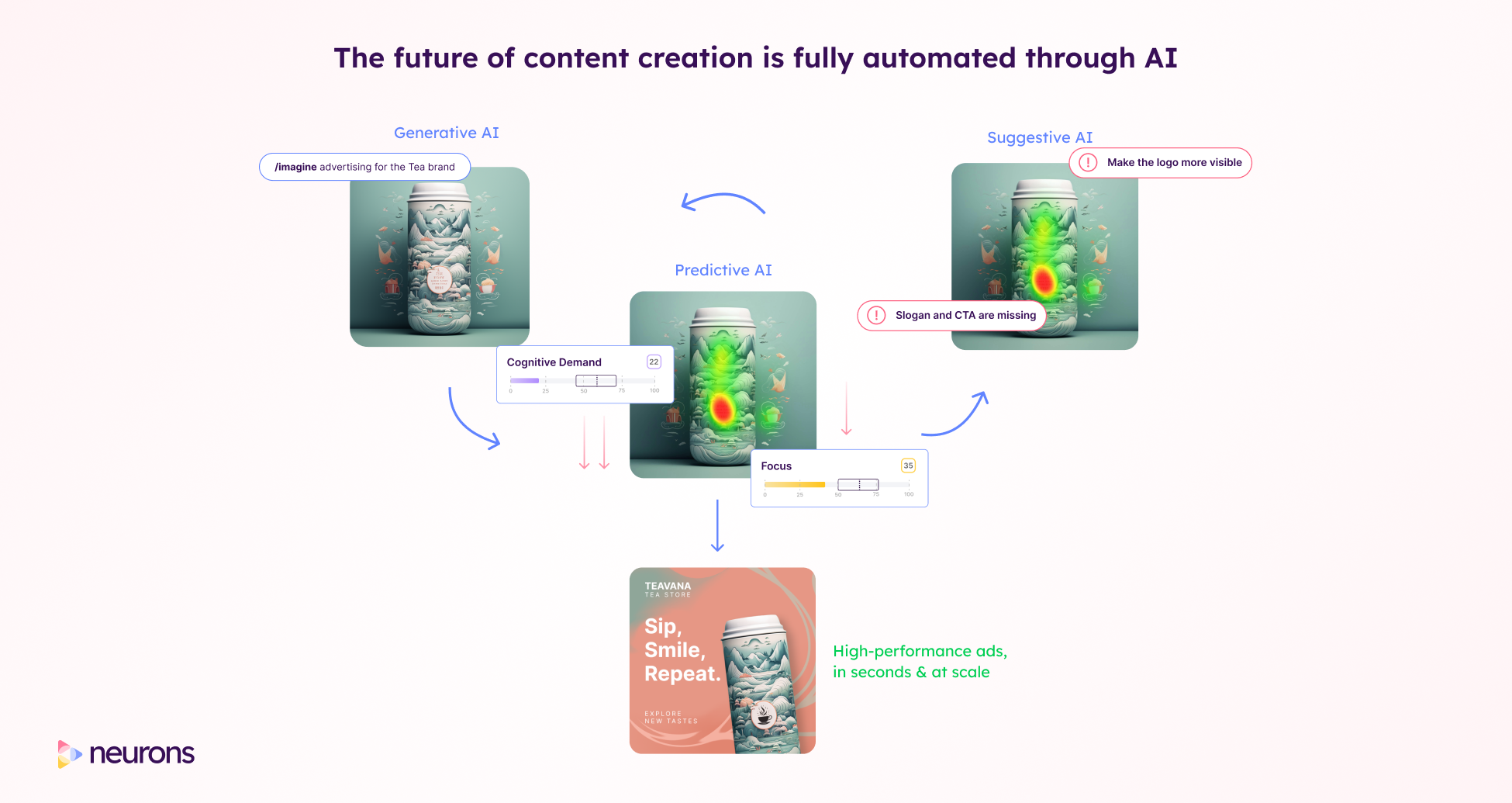
AI is changing how ad testing gets done—from weeks of manual feedback to real-time predictions. Instead of waiting for campaign results or relying solely on survey data, AI tools can forecast attention, simulate audience response, and optimize creatives before they go live. This article outlines how AI is used across the ad testing workflow, from setup to personalization, and what kinds of insights these tools can deliver.
AI is becoming an integral part of ad testing by automating data analysis, predicting audience responses, and speeding up creative optimization. It helps marketers move beyond traditional testing limitations to deliver faster, more precise insights.
6 common AI use cases in ad testing are listed below.
AI models can forecast which parts of an ad will attract and hold viewer attention before the ad even runs live. By analyzing visual elements, motion, and composition, AI helps identify what drives engagement.
This predictive capability allows marketers to optimize creatives early in development, reducing costly trial-and-error and improving effectiveness. For example, Neurons AI can highlight areas likely to be overlooked or underperforming, guiding targeted improvements.
AI can simulate how different audience segments might respond to an ad by analyzing past behavior and preferences. This enables marketers to forecast reactions without needing costly live tests.
By predicting audience responses, brands can tailor creatives and targeting strategies to maximize relevance and impact before launch.
AI analyzes various creative elements—like visuals, copy, and pacing—to evaluate their effectiveness based on historical data and performance benchmarks. This helps marketers understand which aspects contribute most to success.
By identifying strengths and weaknesses in creative assets, AI guides optimization efforts and informs future content strategies.
AI can automate the setup of A/B tests by suggesting relevant variables to test and designing experiments that maximize learning efficiency. This reduces manual effort and speeds up the testing process.
Automated test design ensures that marketers focus on the most impactful creative or targeting changes, improving decision-making speed and accuracy.
AI enables large-scale personalization by dynamically tailoring ad content to individual viewer preferences and behaviors. This ensures messages resonate more deeply with diverse audience segments.
Personalization powered by AI improves engagement and conversion by delivering relevant creative variations without manual customization.
AI accelerates the process of pinpointing top-performing ad variations by analyzing results in real time and highlighting statistically significant winners quickly. This enables marketers to scale what works and pause underperforming creatives sooner.
By speeding up decision-making, AI helps reduce wasted spend and improves overall campaign efficiency.
Side by side comparison is a built in feature in Neurons AI.
AI won’t replace creative instinct—but it can sharpen it. Whether you're predicting attention, automating test design, or scaling personalization, AI helps you test faster, smarter, and with less guesswork. The key is using it as a creative co-pilot—not a shortcut.
The table below summarizes everything covered in this article about ad testing, including definitions, methods, tools, platforms, pros and cons, and more.
Ad testing gives marketers the confidence to invest in creatives that work. Whether you're optimizing for awareness, engagement, or conversion, testing helps you back creative choices with data—not assumptions. With the growing complexity of platforms and formats, a solid testing strategy is no longer a nice-to-have. It’s essential.
Use this guide as a reference point and dive deeper into the linked sections to build a process that fits your goals, timelines, and tech stack. The best-performing ads aren’t always the loudest—they’re the ones that have been tested, tuned, and proven to resonate.